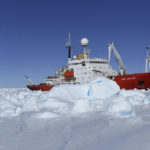External Collaborators
Co-Investigators
David Hodell (University of Cambridge)
Alastair Graham (University of Exeter)
Project Partners
Jim Channell (University of Florida, USA)
Javier Hernández-Molina (Royal Holloway University of London)
Michele Rebesco (Instituto Nazionale di Oceanografia e di Geofisica Sperimatale, Trieste, Italy)
Karsten Gohl (Alfred Wegener Institute for Polar and Marine Research, Bremerhaven, Germany)
Gabriele Uenzelmann-Neben (Alfred Wegener Institute for Polar and Marine Research, Bremerhaven, Germany)
Collaborative projects
Colm Ó Cofaigh (Durham University) and Jenny Horrocks (Durham University/BAS PhD student) – NERC Collaborative Gearing Scheme project (CGS-98) Structural characterisation of Late Quaternary sedimentary sequences recovered from West Antarctic contourite drifts by using three-dimensional X-ray imaging (CT-scanning)
Alex Piotrowski (University of Cambridge) and Tom Williams (BAS/University of Cambridge PhD student) – NERC Collaborative Gearing Scheme project (CGS-100) Tracing and reconstructing the neodymium and carbon isotopic composition of circum-Antarctic waters
Carys Cook (University of Florida) – Antarctic Science Bursary project Tracing the Quaternary evolution of the Antarctic Peninsula and West Antarctic Ice Sheets using lead isotopes in ice-rafted feldspar mineral grains
Nicky White (University of Cambridge) and Kathryn Gunn (University of Cambridge PhD student) – PhD project component on Seismic imaging of oceanographic structures and processes in the Southern Ocean south of the Polar Front
Tom Jordan (BAS) – Collaborative project between BAS science teams on Modelling crustal structure across the Bellingshausen Gravity Anomaly and oceanic fracture zones formed at the Antarctic-Phoenix Ridge through integration of marine potential field and seismic data
Additional contributors
Chuang Xuan (University of Southampton) – working with Jim Channell on deriving relative palaeomagneitc intensity records from the sediment cores collected on cruise JR298
Lara Pérez (now at Geological Survey of Denmark and Greenland) – working with Javier Hernández-Molina on seismic stratigraphic interpretation of contourite drift deposits
Elanor Gowland (NERC Polar Data Centre) – data management
Ricarda Pietsch (PhD student at Alfred Wegener Institute for Polar and Marine Research, Bremerhaven, Germany) – working with Gabriele Uenzelmann Neben and Karsten Gohl on seismic data interpretation
JR298 Shipboard Scientific Party
R.D. Larter BAS Chief Scientist
C.-D. Hillenbrand BAS Marine Geologist
K.A. Hogan BAS Marine Geophysicist
T.A.R.M. Jordan BAS Geophysicist
E.J. Gowland BAS Data Manager
J.E.T. Channell Univ. Florida Palaeomagnetist
C. Cook Univ. Florida Marine Geologist/Geochemist
A.G.C. Graham Univ. Exeter Marine Geophysicist
F.J. Hernández-Molina RHUL Marine Geophysicist
L. Pérez Univ. Granada Marine Geophysicist
A.M. Piotrowski Univ. Cambridge Palaeoceanographer
C. Xuan Univ. Southampton Palaeomagnetist
K.L. Gunn Univ. Cambridge PhD student (Marine Geophysicist)
J. Horrocks Univ. Durham/BAS PhD student (Marine Geologist)
R. Pietsch AWI PhD student (Marine Geophysicist)
T.J. Williams BAS/Univ. Cambridge PhD student (Palaeoceanographer)
S.D. Polfrey BAS AME (Mechanical Engineer)
M.O. Preston BAS AME (Electronic Engineer)
P.E. Morgan BAS AME (Electronic Engineer)
A. England BAS ICT (Computing Engineer)
J.C. Hancock EEL Seismic Systems Engineer
I. Miller EEL Airgun Mechanic
S.G. Paterson EEL Seismic Systems Engineer
BAS = British Antarctic Survey; AWI = Alfred Wegener Institute; RHUL = Royal Holloway University of London; AME = BAS Antarctic & Marine Engineering Section; ICT = BAS Information Communications Technology Section; EEL = Exploration Electronics Ltd



